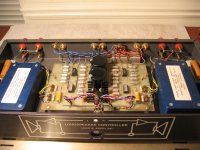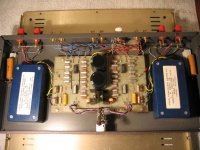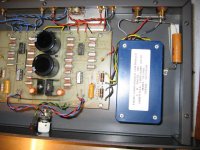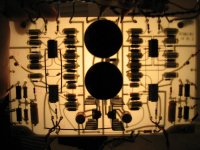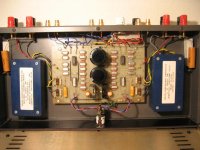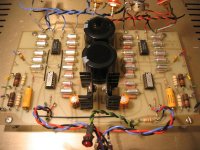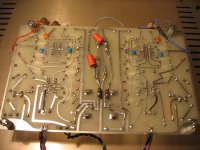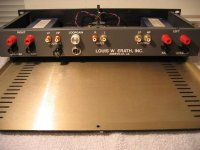Hi All-
I have an "Erath Electronic Suspension Loudspeaker Controller" which I have decided to install in an enclosure with the woofer amp.
The controller consists of a 2-way 24db electronic cross-over @ 125Hz and then the "servo or feedback" circuitry.
In the process of pulling the PCB out of the original enclosure I figured I would try to reengineer the PCB to miniaturize it as much as possible.
The circuit is still covered under US patent so outside of making a "personal use" copy cloning it is not an option.
I will attach several pictures if anyone has free time to assist me with the deconstruction and rebuilding.. We have the technology, we can rebuild it stronger, faster and better...
I have an "Erath Electronic Suspension Loudspeaker Controller" which I have decided to install in an enclosure with the woofer amp.
The controller consists of a 2-way 24db electronic cross-over @ 125Hz and then the "servo or feedback" circuitry.
In the process of pulling the PCB out of the original enclosure I figured I would try to reengineer the PCB to miniaturize it as much as possible.
The circuit is still covered under US patent so outside of making a "personal use" copy cloning it is not an option.
I will attach several pictures if anyone has free time to assist me with the deconstruction and rebuilding.. We have the technology, we can rebuild it stronger, faster and better...
Attachments
SY said:Holy mazolie! The name LWE really gets the nostalgia flowing. They did one of the first "super" speakers back in the '60s. Haven't heard that name in 35 years, at least.
How old is that unit?
The unit is around 4 yrs old..
Mr. Erath is still alive and kicking in Abbeville and Mr. Gerald is still selling his stuff.
Mr. Erath has come out with a few new products but they are still based on "his" production capabilities and that is why I am looking into redoing/shrinking the circuits... Look at the traces on the PCB... That is a 4-5 yr old board!!
Attachments
And lucky # 7
The device compares the input of the woofer amp to the output of the woofer amp and makes adjustments accordingly. It also compensates for the woofer being in an enclosure that resonates at 70(!) Hz.
That's right, I have a stereo pair of 15" woofers each in a 1.25 cu ft box that are flat from 20 Hz up to and cross over at 125hz.
The device compares the input of the woofer amp to the output of the woofer amp and makes adjustments accordingly. It also compensates for the woofer being in an enclosure that resonates at 70(!) Hz.
That's right, I have a stereo pair of 15" woofers each in a 1.25 cu ft box that are flat from 20 Hz up to and cross over at 125hz.
Attachments
Hi Konrad-
Actually yes it does measure current flow via a Toroid in series with the VC.
The Toroid samples the drive current/voltage and gives proportional feedback.
Sorry no woofer data sheet.
The woofers were "custom made" by Eminence 15" with 96 Oz magnets and fs of 26 Hz. Cast aluminum baskets and I *think* 3 inch voice coil.
The 15" in the 1.25 cu ft enclosure resonate @ 70 Hz.
Actually yes it does measure current flow via a Toroid in series with the VC.
The Toroid samples the drive current/voltage and gives proportional feedback.
Sorry no woofer data sheet.
The woofers were "custom made" by Eminence 15" with 96 Oz magnets and fs of 26 Hz. Cast aluminum baskets and I *think* 3 inch voice coil.
The 15" in the 1.25 cu ft enclosure resonate @ 70 Hz.
Well, a google search how to : obtain thiele small parameter
You will find a way or two. if this is to bee adapted to other elements and boxes.
By the look it seems like quad opamps are used. I guess two sections of 12dB/okt for high and lowpass. Like you say 24dB/okt high and lowpass.
looks like servo loop gain is adjustable to fit amplifier.
The BIG unknown parameter is then the toroid!
You happen to know how to find the most important values Lp Ls Rp Rs V1/V2 ? But as current is used I1/V2 and..... then.... and...
Toroid wich must kind of feed back the back emf~ will make current in transformer and normalised~equalised signal is comparable.
There is also a few different prinsippes in servo like PID , Velossity (can bee worked out with like superposition with bode limits) and others.
Afterall back emf generates a voltage wich makes a current in transformer and element, wich makes a voltage output.... Wich again is the sense signal. I bet you will find the signal 180* turned at the bottom end. And "normal" for the higpass. Miksed on the board or separately treated for "low" and "high" section.
After all current is the meashure ie current compensation, positive at the bottom with transformer rolloff at the werry bottom, and negative feedback in the mid/high range ( mid range ca 70 Hz ). BUT it looks like there is a overall voltage feedback also ?
This is a closed box design i supose?
Have you worked out the schematik yet ?
Two opamps in treating feedback, one for differensial and a buffer would bee abt 4 opamps in the servo.
You will find a way or two. if this is to bee adapted to other elements and boxes.
By the look it seems like quad opamps are used. I guess two sections of 12dB/okt for high and lowpass. Like you say 24dB/okt high and lowpass.
looks like servo loop gain is adjustable to fit amplifier.
The BIG unknown parameter is then the toroid!
You happen to know how to find the most important values Lp Ls Rp Rs V1/V2 ? But as current is used I1/V2 and..... then.... and...
Toroid wich must kind of feed back the back emf~ will make current in transformer and normalised~equalised signal is comparable.
There is also a few different prinsippes in servo like PID , Velossity (can bee worked out with like superposition with bode limits) and others.
Afterall back emf generates a voltage wich makes a current in transformer and element, wich makes a voltage output.... Wich again is the sense signal. I bet you will find the signal 180* turned at the bottom end. And "normal" for the higpass. Miksed on the board or separately treated for "low" and "high" section.
After all current is the meashure ie current compensation, positive at the bottom with transformer rolloff at the werry bottom, and negative feedback in the mid/high range ( mid range ca 70 Hz ). BUT it looks like there is a overall voltage feedback also ?
This is a closed box design i supose?
Have you worked out the schematik yet ?
Two opamps in treating feedback, one for differensial and a buffer would bee abt 4 opamps in the servo.
5,086,473 Feedback system for a sub-woofer loudspeaker
http://patft.uspto.gov/netacgi/nph-...ouis)&OS=erath+and+louis&RS=(erath+AND+louis)
http://patft.uspto.gov/netacgi/nph-...ouis)&OS=erath+and+louis&RS=(erath+AND+louis)
Attachments
Konrad said:Uh ? look at 38 on the figure. defined gain would bee nice !
Hi-
#38 is the "user's" amplifier of choice. requirements are:
Non-inverting
>100WPC into 8 Ohms
The diagram is from the patent papers. In the description of the "contraption" is the explanation of the different numbers.
Great post. Very intriguing object. Is there a User Manual ?
Obviously this is a quite special analog stereo 2-way active crossover operating at 250 Hz.
Where is the power supply connector ? Is it the 4-pin male socket located underneath the "loopgain" adjustment ? Say a +15DC pin, a -15VDC pin, and two ground pins. Only one fuse ? Strange ...
The "loopgain" adjustment implies a feedback loop somewhere. Probably, the controller is internally surrounding the bass power amp with some circuitry providing a) some more gain (adjustable) and b) some special feedback (also adjustable). That's clever : no need to open the bass power amp for making its feedback network available to the Controller.
Probably, the blue boxes are in metal, containing elements that need extra shielding for avoiding hum and diaphony. There are only 4 wires going in each blue box. This could be the current transformer used as voice coil current sensor. One pair in, one pair out. Galvanic isolation.
I have a thin doubt about the adjustability of the Controller. When you hook it on a power amp and a closed box as woofer, you face four independent parameters : db/watt (box sensitivity), Q (box resonance factor), Fc (box resonance frequency) and Av (power amp voltage amplification).
You would expect the Controller to feature those four adjustments.
The Controller only features the db/watt bass box sensitivity ("bass" in front) and Av power amp voltage amplification ("loopgain" at the back).
The Controller seems to miss the Q (box resonance factor) and the Fc (box resonance frequency) adjustments.
Thanks to the db/watt box sensitivity ("bass" in front) adjustment, the user can adjust the LF level for matching it to the HF level, even if the power amps have no volume controls.
About the speaker driver sitting in the closed box, there is a hidden parameter also needing care which is the Xmax (coil linear travel distance). I expected the Controller to carefully deal with this, for avoiding sending infra-bass content to speaker drivers that cannot deal with it. I confess this is not a simple matter, as the coil travel is defined both by the frequency (low frequency commands long coil travel), and intensity (loud sound commands long coil travel). Such circuit would need to read the audio content, possibly in advance (that's quite impossible with analog circuitry), and gently change the cutoff frequency of a high-order Butterworth highpass filter, for maintaining the expected Xmax within a given limit, defined by a potentiometer. Call it a job. Expect artefacts.
Realizing that there are eight opamps per channel, one can suppose that some got used as :
- Butterworth highpass filters with fixed frequency, say 35 Hz (two opamps for a 4th-order) for dealing in a simple manner, artefact-free, with the Xmax potential issue
- frequency shaping network, adjustable amplification, gyrator (two opamps)
- Linkwitz-Riley 2-way crossover at 250 Hz (two opamps for the 4th-order LP and two opamps for the 4th-order HP)
Such Controller appears as more complicated (because of the feedback, because of the current transformer) than a Linkwitz transform (aka deep bass equalizer).
On the other hand, as there are no adjustments for Q and Fc, such Controller appears inferior to a Linkwitz transform.
Given this, what kind of benefits can we hope from such "Erath Electronic Suspension Loudspeaker Controller" ?
"I had a dream" that the Erath Controller, on top of extending the bass range, on top of ironing out any boomy resonance, reading the coil current, was able to detect in realtime a situation like magnetic hysteresis and suspension compliance hysteresis, and instantaneously request current from the power amp for removing all kind of erratic coil behaviors near the zero point.
"I had a dream" that the Erath Controller, on top of extending the bass range, on top of ironing out any boomy resonance, reading the coil current, was able to detect in realtime a situation like being close to magnetic saturation, or being close to Xmax, and instantaneously request more current from the power amp for remaining linear as long as possible, before completely entering magnetic saturation, or before completely exceeding the Xmax.
"I had a dream" that the Erath Controller, on top of extending the bass range, on top of ironing out any boomy resonance, reading the coil current, was able to detect in realtime a situation like the box air volume compliance not remaining linear (essentially, it's parabolic), and instantaneously request current from the power amp for restoring linearity.
"I had a dream" that the Erath Controller, on top of extending the bass range, on top of ironing out any boomy resonance, reading the coil current, was able to drive the coil very firmly even at the zero point, even at the zero speed. This can be compared to Eduardo Del Pueyo (a famous pianist in the sixties) discovering and teaching that a same piano will sound differently, if you hold your finger lose, compared to holding your finger very firmly on the keyboard, even at mid travel. Speaking about a loudspeaker membrane, with the coil acting as finger, we must compare a situation where the finger completely vanishes two times per cycle, with a situation where the finger is always there, driving the coil very firmly. It's about torque vanishing twice per cycle, or torque remaining always very firmly. For the exact same coil travel. Yes there will be a massive difference like detected by Eduardo Del Pueyo, because by keeping always the drive very firm, you shift all cone resonances to high frequencies, possibly less audible or less harmful, possibly absorbed by the membrane material.
Those four "dreamed" features, of course no Linkwitz transform can deliver.
The dream and the hope do come from the closed loop feedback implemented by the Erath Controller.
And by popular demand, feedback means "distortion reduction".
Is this true in such particular case ?
How to determine the real benefits of the Erath Controller ?
I'd like to sketch a LTspice simulation, with :
- a non-linear BL factor
- a non-linear capacitor figuring the compliance.
Is this feasible ?
Obviously this is a quite special analog stereo 2-way active crossover operating at 250 Hz.
Where is the power supply connector ? Is it the 4-pin male socket located underneath the "loopgain" adjustment ? Say a +15DC pin, a -15VDC pin, and two ground pins. Only one fuse ? Strange ...
The "loopgain" adjustment implies a feedback loop somewhere. Probably, the controller is internally surrounding the bass power amp with some circuitry providing a) some more gain (adjustable) and b) some special feedback (also adjustable). That's clever : no need to open the bass power amp for making its feedback network available to the Controller.
Probably, the blue boxes are in metal, containing elements that need extra shielding for avoiding hum and diaphony. There are only 4 wires going in each blue box. This could be the current transformer used as voice coil current sensor. One pair in, one pair out. Galvanic isolation.
I have a thin doubt about the adjustability of the Controller. When you hook it on a power amp and a closed box as woofer, you face four independent parameters : db/watt (box sensitivity), Q (box resonance factor), Fc (box resonance frequency) and Av (power amp voltage amplification).
You would expect the Controller to feature those four adjustments.
The Controller only features the db/watt bass box sensitivity ("bass" in front) and Av power amp voltage amplification ("loopgain" at the back).
The Controller seems to miss the Q (box resonance factor) and the Fc (box resonance frequency) adjustments.
Thanks to the db/watt box sensitivity ("bass" in front) adjustment, the user can adjust the LF level for matching it to the HF level, even if the power amps have no volume controls.
About the speaker driver sitting in the closed box, there is a hidden parameter also needing care which is the Xmax (coil linear travel distance). I expected the Controller to carefully deal with this, for avoiding sending infra-bass content to speaker drivers that cannot deal with it. I confess this is not a simple matter, as the coil travel is defined both by the frequency (low frequency commands long coil travel), and intensity (loud sound commands long coil travel). Such circuit would need to read the audio content, possibly in advance (that's quite impossible with analog circuitry), and gently change the cutoff frequency of a high-order Butterworth highpass filter, for maintaining the expected Xmax within a given limit, defined by a potentiometer. Call it a job. Expect artefacts.
Realizing that there are eight opamps per channel, one can suppose that some got used as :
- Butterworth highpass filters with fixed frequency, say 35 Hz (two opamps for a 4th-order) for dealing in a simple manner, artefact-free, with the Xmax potential issue
- frequency shaping network, adjustable amplification, gyrator (two opamps)
- Linkwitz-Riley 2-way crossover at 250 Hz (two opamps for the 4th-order LP and two opamps for the 4th-order HP)
Such Controller appears as more complicated (because of the feedback, because of the current transformer) than a Linkwitz transform (aka deep bass equalizer).
On the other hand, as there are no adjustments for Q and Fc, such Controller appears inferior to a Linkwitz transform.
Given this, what kind of benefits can we hope from such "Erath Electronic Suspension Loudspeaker Controller" ?
"I had a dream" that the Erath Controller, on top of extending the bass range, on top of ironing out any boomy resonance, reading the coil current, was able to detect in realtime a situation like magnetic hysteresis and suspension compliance hysteresis, and instantaneously request current from the power amp for removing all kind of erratic coil behaviors near the zero point.
"I had a dream" that the Erath Controller, on top of extending the bass range, on top of ironing out any boomy resonance, reading the coil current, was able to detect in realtime a situation like being close to magnetic saturation, or being close to Xmax, and instantaneously request more current from the power amp for remaining linear as long as possible, before completely entering magnetic saturation, or before completely exceeding the Xmax.
"I had a dream" that the Erath Controller, on top of extending the bass range, on top of ironing out any boomy resonance, reading the coil current, was able to detect in realtime a situation like the box air volume compliance not remaining linear (essentially, it's parabolic), and instantaneously request current from the power amp for restoring linearity.
"I had a dream" that the Erath Controller, on top of extending the bass range, on top of ironing out any boomy resonance, reading the coil current, was able to drive the coil very firmly even at the zero point, even at the zero speed. This can be compared to Eduardo Del Pueyo (a famous pianist in the sixties) discovering and teaching that a same piano will sound differently, if you hold your finger lose, compared to holding your finger very firmly on the keyboard, even at mid travel. Speaking about a loudspeaker membrane, with the coil acting as finger, we must compare a situation where the finger completely vanishes two times per cycle, with a situation where the finger is always there, driving the coil very firmly. It's about torque vanishing twice per cycle, or torque remaining always very firmly. For the exact same coil travel. Yes there will be a massive difference like detected by Eduardo Del Pueyo, because by keeping always the drive very firm, you shift all cone resonances to high frequencies, possibly less audible or less harmful, possibly absorbed by the membrane material.
Those four "dreamed" features, of course no Linkwitz transform can deliver.
The dream and the hope do come from the closed loop feedback implemented by the Erath Controller.
And by popular demand, feedback means "distortion reduction".
Is this true in such particular case ?
How to determine the real benefits of the Erath Controller ?
I'd like to sketch a LTspice simulation, with :
- a non-linear BL factor
- a non-linear capacitor figuring the compliance.
Is this feasible ?
Last edited:
*Is there a User Manual?
Yes
*Obviously this is a quite special analog stereo 2-way active crossover operating at 250 Hz.
Crosses over @ 125Hz
*Where is the power supply connector ? Is it the 4-pin male socket located underneath the "loopgain" adjustment ?
Yes
*Say a +15DC pin, a -15VDC pin, and two ground pins. Only one fuse ? Strange ...
18VAC in from the wall wart. Rectified and filtered in the main chassis.
*The "loopgain" adjustment implies a feedback loop somewhere. Probably, the controller is internally surrounding the bass power amp with some circuitry providing a) some more gain (adjustable) and b) some special feedback (also adjustable). That's clever : no need to open the bass power amp for making its feedback network available to the Controller.
*Probably, the blue boxes are in metal, containing elements that need extra shielding for avoiding hum and diaphony. There are only 4 wires going in each blue box. This could be the current transformer used as voice coil current sensor. One pair in, one pair out. Galvanic isolation.
Negative. The blue boxes are Mr. Eraths "sensitive information circuit" and are just a coil, resister and cap potted in expoxy. It is there to electronically model the voice coil of the woofer for feedback purposes.
I have a thin doubt about the adjustability of the Controller. When you hook it on a power amp and a closed box as woofer, you face four independent parameters : db/watt (box sensitivity), Q (box resonance factor), Fc (box resonance frequency) and Av (power amp voltage amplification).
15" Emience high sensitivity woofer in 1.25cft sealed enclosure tuned to resonat @ 70Hz.
*You would expect the Controller to feature those four adjustments.
*The Controller only features the db/watt bass box sensitivity ("bass" in front) and Av power amp voltage amplification ("loopgain" at the back).
Front knob only LOWERS the gain of the woofer circuit as it is higher that the fixed 18db/oct high pass circuit.
*The Controller seems to miss the Q (box resonance factor) and the Fc (box resonance frequency) adjustments.
Servo uses the predicted enviornment model of a specially made / designed woofer system (driver and enclosure) to go with it. It is NOT for use with any sub.
*Thanks to the db/watt box sensitivity ("bass" in front) adjustment, the user can adjust the LF level for matching it to the HF level, even if the power amps have no volume controls.
Exactly. High pass section is fixed, low pass is boosted by ~6db and high sensitivity woofer used.
*About the speaker driver sitting in the closed box, there is a hidden parameter also needing care which is the Xmax (coil linear travel distance). I expected the Controller to carefully deal with this, for avoiding sending infra-bass content to speaker drivers that cannot deal with it. I confess this is not a simple matter, as the coil travel is defined both by the frequency (low frequency commands long coil travel), and intensity (loud sound commands long coil travel). Such circuit would need to read the audio content, possibly in advance (that's quite impossible with analog circuitry), and gently change the cutoff frequency of a high-order Butterworth highpass filter, for maintaining the expected Xmax within a given limit, defined by a potentiometer. Call it a job. Expect artefacts.
The unit has a rumble filter (high pass) on the input set for 20 or 25Hz.
*Given this, what kind of benefits can we hope from such "Erath Electronic Suspension Loudspeaker Controller" ?
Flat, accurate, NON-resonant bass down to 20Hz. Sounds really weird at first not having the woofer / box resonace that we are all subconciously used to but once you hear it you miss it in other systems.
*And by popular demand, feedback means "distortion reduction".
*Is this true in such particular case ?
The amp is in the feedback loop and the signal into the unit is compared to the output of the amp to the woofer. Differences are adjusted for. Does that reduce distortion I can't answer but it definately sound more natural and musical.
*How to determine the real benefits of the Erath Controller ?
Try mine and see. It's not a sales pitch it's a request to get a more compact better crossover unit version small enough to put INTO the amplifier chassis and make a dual mono version for bi-amping active speakers. That is my goal. I have Hypex UcD amps and this controller and I am trying to make active speakers with mono parts in chassis sitting on the side or back of the speakers.
Yes
*Obviously this is a quite special analog stereo 2-way active crossover operating at 250 Hz.
Crosses over @ 125Hz
*Where is the power supply connector ? Is it the 4-pin male socket located underneath the "loopgain" adjustment ?
Yes
*Say a +15DC pin, a -15VDC pin, and two ground pins. Only one fuse ? Strange ...
18VAC in from the wall wart. Rectified and filtered in the main chassis.
*The "loopgain" adjustment implies a feedback loop somewhere. Probably, the controller is internally surrounding the bass power amp with some circuitry providing a) some more gain (adjustable) and b) some special feedback (also adjustable). That's clever : no need to open the bass power amp for making its feedback network available to the Controller.
*Probably, the blue boxes are in metal, containing elements that need extra shielding for avoiding hum and diaphony. There are only 4 wires going in each blue box. This could be the current transformer used as voice coil current sensor. One pair in, one pair out. Galvanic isolation.
Negative. The blue boxes are Mr. Eraths "sensitive information circuit" and are just a coil, resister and cap potted in expoxy. It is there to electronically model the voice coil of the woofer for feedback purposes.
I have a thin doubt about the adjustability of the Controller. When you hook it on a power amp and a closed box as woofer, you face four independent parameters : db/watt (box sensitivity), Q (box resonance factor), Fc (box resonance frequency) and Av (power amp voltage amplification).
15" Emience high sensitivity woofer in 1.25cft sealed enclosure tuned to resonat @ 70Hz.
*You would expect the Controller to feature those four adjustments.
*The Controller only features the db/watt bass box sensitivity ("bass" in front) and Av power amp voltage amplification ("loopgain" at the back).
Front knob only LOWERS the gain of the woofer circuit as it is higher that the fixed 18db/oct high pass circuit.
*The Controller seems to miss the Q (box resonance factor) and the Fc (box resonance frequency) adjustments.
Servo uses the predicted enviornment model of a specially made / designed woofer system (driver and enclosure) to go with it. It is NOT for use with any sub.
*Thanks to the db/watt box sensitivity ("bass" in front) adjustment, the user can adjust the LF level for matching it to the HF level, even if the power amps have no volume controls.
Exactly. High pass section is fixed, low pass is boosted by ~6db and high sensitivity woofer used.
*About the speaker driver sitting in the closed box, there is a hidden parameter also needing care which is the Xmax (coil linear travel distance). I expected the Controller to carefully deal with this, for avoiding sending infra-bass content to speaker drivers that cannot deal with it. I confess this is not a simple matter, as the coil travel is defined both by the frequency (low frequency commands long coil travel), and intensity (loud sound commands long coil travel). Such circuit would need to read the audio content, possibly in advance (that's quite impossible with analog circuitry), and gently change the cutoff frequency of a high-order Butterworth highpass filter, for maintaining the expected Xmax within a given limit, defined by a potentiometer. Call it a job. Expect artefacts.
The unit has a rumble filter (high pass) on the input set for 20 or 25Hz.
*Given this, what kind of benefits can we hope from such "Erath Electronic Suspension Loudspeaker Controller" ?
Flat, accurate, NON-resonant bass down to 20Hz. Sounds really weird at first not having the woofer / box resonace that we are all subconciously used to but once you hear it you miss it in other systems.
*And by popular demand, feedback means "distortion reduction".
*Is this true in such particular case ?
The amp is in the feedback loop and the signal into the unit is compared to the output of the amp to the woofer. Differences are adjusted for. Does that reduce distortion I can't answer but it definately sound more natural and musical.
*How to determine the real benefits of the Erath Controller ?
Try mine and see. It's not a sales pitch it's a request to get a more compact better crossover unit version small enough to put INTO the amplifier chassis and make a dual mono version for bi-amping active speakers. That is my goal. I have Hypex UcD amps and this controller and I am trying to make active speakers with mono parts in chassis sitting on the side or back of the speakers.
- Status
- This old topic is closed. If you want to reopen this topic, contact a moderator using the "Report Post" button.
- Home
- Amplifiers
- Solid State
- Reverse engineering a servo controller?
